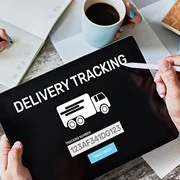72% of supply chain businesses plan to increase their investment in IoT and RFID technologies to achieve real-time inventory visibility while 52% of them have reported full or moderate implementation.
This widespread adoption is not just a fleeting trend; it signifies a profound transformation in how goods are tracked, managed, and delivered. As supply chains become more intricate with global operations and multiple touchpoints, the need for real-time tracking of goods and assets is also growing. IoT technology is revolutionizing the sector by enabling real-time tracking, predictive maintenance, and optimized transportation, all while significantly reducing costs and enhancing efficiency.
This article explores the key areas where IoT has the most disruptive impacts, the challenges and considerations of system-wide rollout, and the future trends poised to shape this industry.
Key Areas of Disruption
IoT technology is reshaping traditional practices and introducing new efficiencies by enabling exceptional levels of connectivity, advanced inventory management systems, optimized transportation routes, and logistics operations. Here are some of the key areas of disruption.
-
Real-time Goods and Assets Surveillance
IoT enables continuous tracking of items throughout the supply chain by embedding smart sensors and GPS technology into products and vehicles. This allows companies to monitor the location and condition of goods in real-time.
For instance, two major areas benefiting from this application are the transportation of perishable goods and electronics.
Smart sensors monitor humidity, temperature, and other environmental conditions while transporting perishable goods such as pharmaceuticals or fresh produce and send instant alerts if parameters deviate from the acceptable range.
Similarly, high-value merchandise such as luxury goods and electronics can be supervised in real-time to prevent theft and guarantee they arrive damage-free.
-
Predictive Maintenance
Anticipatory upkeep powered by intelligent sensors is revolutionizing the way businesses manage their vehicles and machinery. These sensors collect data on various metrics such as pressure, temperature, and vibration by monitoring the equipment's condition. Advanced analytics process this data to predict maintenance schedules and failure.
Some of the prominent use cases include warehouse robotics and automated fleet management.
In fleet management, IoT sensors are installed on delivery vehicles and trucks to monitor tire pressure, engine health, and fuel consumption. Analyzing this data helps companies anticipate when a vehicle requires servicing, which prevents unexpected breakdowns.
Similarly, in warehouse robotics, connected sensors track the performance of automated systems to identify signs of wear and tear, which might lead to malfunctions. This enables proactive maintenance scheduling for smoother and more efficient operations.
-
Enhanced Inventory Management
Automated inventory tracking has transformed traditional inventory management into a more efficient and accurate process. IoT enables real-time monitoring of movements, stock levels, and conditions by integrating connectivity and intelligent sensors into shelving and storage systems.
Electronic reordering systems and smart shelves are some good examples of enhanced inventory management.
Smart shelves are equipped with weight sensors to detect when products are added or removed. This sends instant updates to inventory databases, which allows businesses to maintain accurate stock counts without manual checks.
Automated reordering systems use IoT data to trigger order restocking when inventory levels deviate from predefined thresholds. This keeps essential items available, prevents stockouts, and minimizes overstock situations.
-
Optimized Transportation with IoT in Logistics
Integrated smart devices are empowering businesses to gain instant updates on their transportation networks, from traffic conditions to vehicle performance.
One of the significant ways IoT optimizes transportation is through smart routing. Here, the systems identify the most efficient delivery routes by analyzing real-time traffic data. This prevents traffic congestion and reduces travel time to speed up delivery times and lower fuel consumption. Additionally, intelligent fleet management systems monitor vehicle health and schedule maintenance to prevent breakdowns.
Another primary application of IoT in transportation is the use of autonomous vehicles. These are delivery drones and self-driving trucks equipped with AI algorithms and advanced sensors, which traverse complex environments with minimal human intervention. Autonomous vehicles operate around the clock to increase delivery speed and reduce labor costs.
Challenges and Considerations of Implementing IoT in Supply Chain
The combination of the Internet of Things and supply chain has disrupted the way this sector functions. However, several challenges and considerations must be evaluated and addressed while adopting IoT for supply chain and logistics. Cybersecurity, massive data volumes, integration with existing systems, and initial costs are some of the challenges of embracing this technology.
-
Security Concerns
One of the most significant challenges in implementing smart technologies in the supply chain and the Internet of Things in logistics is ensuring robust cybersecurity. IoT devices often operate across various networks, which makes them susceptible to cyberattacks such as data breaches, Distributed Denial of Service (DDoS), and unauthorized access.
Multiple devices increase the attack surface and necessitate advanced security measures such as secure boot mechanisms, two-factor authentication, and end-to-end encryption. Regular vulnerability assessments and prompt firmware updates help mitigate security risks and protect sensitive information from cyber threats.
-
Data Management
The implementation of IoT generates an enormous amount of data, often referred to as big data. This data comes from numerous sensors and devices, which becomes a challenge for data storage, processing, and analysis. Traditional data management systems may not be equipped to handle the velocity, variety, and volume of IoT data.
Businesses address this by investing in scalable cloud storage solutions, data lakes, and advanced analytics platforms such as Hadoop and Spark. This helps them process and gain actionable insights from historical and live-streaming data. Moreover, data governance frameworks should also be established to ensure data quality, consistency, and compliance with regulations such as GDPR.
-
Integration
Legacy systems may not be compatible with modern IoT devices, which require significant upgrades or even complete overhauls. Interoperability standards and APIs are essential to facilitate seamless data exchange between IoT devices and Warehouse Management Systems (WMS). Middleware solutions and IoT platforms bridge the gap, but the integration process often demands skilled IT professionals and substantial time investment.
-
Cost
While the benefits of IoT in supply chain and logistics are substantial, the initial investment associated withIoT app development services can be high. Costs include purchasing IoT devices, installing infrastructure, and implementing advanced analytics platforms. In addition, ongoing expenses such as maintenance, updates, and cybersecurity measures add to the financial outlay.
Conducting a thorough cost-benefit analysis helps businesses determine the ROI of their IoT projects. Long-term gains in cost savings, efficiency, and customer satisfaction justify the investment. This enables enterprises to manage cash flow during transition and secure initial and subsequent funding.
Charting the Course to a Connected Supply Chain
Companies are achieving higher levels of agility that were previously unattainable with connected devices and intelligent systems. The bigger picture for IoT supply chain management and logistics is fully connected processes where data flows seamlessly across all touchpoints. This connectivity not only enhances operational efficiency but also fosters collaboration and integration across the entire supply chain network. The result is a more connected, agile, and intelligent supply chain that can adapt to changing conditions and anticipate future needs. The time to act is now. Investing in IoT technology enables businesses to experience new levels of efficiency, visibility, and control.
Get a FREE QUOTE!
Decide in 24 hours whether outsourcing will work for you.
Have specific requirements? Email us at: ![]()
Key Differentiators
Testimonials Business
Analysis Business Modeling
Process at O2I Software
Development Expertise Software
Development Team Project
Quality Standards Clinical Trial
Software Development Telecom
Software Gaming
Software Viral Marketing
Game Development Application
Development Process Technical
Analysis Process e-Learning
Solutions Process Project
Management Process Tools & Technologies J2EE
Programming Service Oriented
Architecture Database
Management Systems
-
 Outsource2india Enabled a Hospital Chain in the US to Streamline Internal Communication Via a Top-notch Team App
Outsource2india Enabled a Hospital Chain in the US to Streamline Internal Communication Via a Top-notch Team App
-
 Outsource2india Provided Excellent Workday Support Services to a US-based Real-Estate Client
Outsource2india Provided Excellent Workday Support Services to a US-based Real-Estate Client
-
 Outsource2india Empowered a Dubai-based Client to Streamline Workflow with Outstanding SN App Integrations
Outsource2india Empowered a Dubai-based Client to Streamline Workflow with Outstanding SN App Integrations
-
 Outsource2india Developed a Ticketing Software Using ServiceNow for a US-based Firm
Outsource2india Developed a Ticketing Software Using ServiceNow for a US-based Firm
-
 Outsource2india Helped a Data Analytics Company with Power BI Solutions
Outsource2india Helped a Data Analytics Company with Power BI Solutions -
 Outsource2india Provided ServiceNow Solutions to a UAE-based Logistics Firm
Outsource2india Provided ServiceNow Solutions to a UAE-based Logistics Firm
Frequently Asked Questions (FAQs)
What is the application of IoT in supply chain and logistics?
IoT is used in supply chain and logistics to connect devices for monitoring and managing the flow of goods, ensuring process transparency, and maximizing workflow efficiency.
What advantages does IoT offer for my supply chain?
Implementing IoT enables you to monitor processes in real-time, improve route optimization, and enhance demand forecasting, which leads to higher efficiency and cost savings.
What are some applications of the Internet of Things in supply chain and logistics?
IoT is used in logistics for asset tracking, environmental monitoring of sensitive goods, and dynamic route planning, which contributes to more efficient and reliable operations.
In what ways does IoT enhance inventory management?
IoT enhances inventory management by providing precise location data, enabling automated reordering processes, and ensuring optimal stock levels based on real-time demand.
Is it secure to implement IoT technology within supply chain operations?
Robust security measures such as end-to-end encryption and secure data transmission are a part of IoT implementation. This safeguards your supply chain operations from potential threats.

















